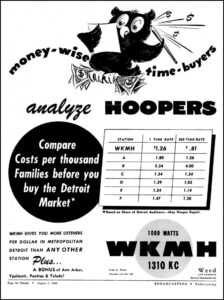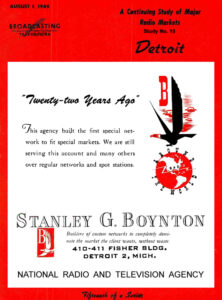 75 Years Ago, This Month, Broadcasting Magazine Reported In-Depth On the Status of the Radio Market in Detroit, Michigan
75 Years Ago, This Month, Broadcasting Magazine Reported In-Depth On the Status of the Radio Market in Detroit, Michigan
WHAT’S in a nickname? Known for two generations as “The Motor City” and during World War II as “The Arsenal of Democracy,” Detroit prefers to be called “The City Where Life Is Worth Living” or “The Dynamic City.”
 But the clue to understanding and selling the Detroit market lies in the fact that the people consider it a good place to make a good life. The Detroit area’s 2,725,000 residents are home-owners. In the city proper there are 326,111 single and two-family dwellings, as against only 14,275 multiple units. So it is plain that any sales campaign directed at the cliff-dwellers of the East will miss the heart of Detroit.
But the clue to understanding and selling the Detroit market lies in the fact that the people consider it a good place to make a good life. The Detroit area’s 2,725,000 residents are home-owners. In the city proper there are 326,111 single and two-family dwellings, as against only 14,275 multiple units. So it is plain that any sales campaign directed at the cliff-dwellers of the East will miss the heart of Detroit.
[Note: Mouse click over (pc) or tap and stretch (mobile screen) over the WKMH ad image for largest detailed read.]
A majority of Detroit’s homes are owner occupied, with the percentage rising each year, due partly to the post-war shortage of rentals but mostly to the character and ambitions of the population.
And this is only part of the market. Adjacent municipalities add 81,700 dwelling units, and unincorporated areas increase this by 41,300, with an even higher ratio of single, owner occupied units than the city proper.
A Detroit News estimate gives a total of 577,000 dwelling units in the city or a metropolitan area total of 700,000.
And they are home-staying people, too. Night clubs have rocky going, but neighborhood taverns are numerous. These Detroiters must be sold in their homes, which explains the success of the outstanding radio and television stations in the area.
The terrific Detroit market is split among a relatively small number of stations, thus making it possible for each to show a very respectable listening public at any given time. The AM field is covered by eight stations: WWJ (NBC), WJR (CBS), WXYZ (ABC), CKLW (MBS), WJBK, WJLB, WEXL and WKMH. WEXL and WKMH are located in suburbs.
All these except WKMH give simultaneous FM broadcasting. In addition, there are four exclusive FM operations in Detroit. Three are commercial – WDET (FM), WJJW (FM), WLDM (FM) – and one is non-commercial, WDTR (FM), operated by the Board of Education.
Just how big is this Detroit radio market? In 1948, time sales of the eight AM outlets totaled $7,800,000, with the billing of the three FM-only stations pushing the total over $8 million. In addition, there is a TV market that will add up to better than a half -million dollars this year at a very conservative estimate, based on 1948, plus growth in 1949. Breakdowns between local and national billing aren’t quite so accurate, but a good estimate would be that $3 million comes from local advertisers alone.
It is hard, sometimes, to convince non-Detroiters that there is anything else sold in the city but automobiles, and that it is not unique for someone to work anywhere but in the huge auto plants. The city doesn’t try to hide its dependence on, and pride in, the sprawling factories that made it world famous, but it likes to emphasize the hundreds of other important segments of its economic life.
As one production man put it, “Nobody makes nuthin’ until we make the tools for them.” And he was almost right. Tool and die companies in the Detroit area cover five full pages of type in the telephone directory, and are busy the year around turning out the means of production for industries all over the world.
Founded in 1701 by Antoine Laumet de la Mothe Cadillac, as a fort to contain the English in the West, the city has been a center of commerce ever since. In 1948, the total retail sales in Wayne County were $2,892,344,000, a gain of 13% over 1947, which had been the biggest year in history until then.
Sales like this can only be made to well -paid workers, which is what the Detroit area specializes in. The average hourly rate of a factory worker in Detroit had risen to $1.71 by the end of last year, which gives a weekly paycheck for 40 hours of $68.40. The high take-home of the city’s workers was reflected in federal bank records which show a jump of $20 million since last year, and a gain in savings deposits of $5 million.
The metropolitan area’s market of 2,725,000 residents tells only part of the story. Detroit is also the shopping center for much of southern Oakland and Macomb counties just to the north, well within the effective radius of the Detroit stations. At the turn of the century Detroit, of the wide shady streets and lovely homes running out East Jefferson along the river-front, had a population of only 285,000. But the invention of the automobile and the circumstances that induced Detroit to take this new industry to its heart and make it into the leading single industry in the country, transformed a quiet town into the fourth city of the nation, and the third greatest manufacturing center.
Detroit’s 144 square miles rise so evenly from the 11 miles of frontage on the Detroit River that the terrain appears level. There is a man-made skyline though, in the form of ranges of skyscrapers and banks of smokestacks, culminating in the tower of the Penobscot Bldg., 657 feet from the sidewalk. This, in turn, is topped by radio, for the WWJ-FM and TV operations are handled from the top of this building, with the antenna towering over the entire city.
Commercial radio came early to Detroit. WWJ, the Detroit News station — at that time W8MK, later WBL on Oct. 13, 1921, and finally WWJ on March 3, 1922 -began to broadcast regular programs on Aug. 20, 1920, and has been in continuous operation since that date.
There has been a constant dispute over whether or not WWJ antedates KDKA Pittsburgh, mainly turning on what is considered “regular programs.” This was the beginning of a long line of firsts claimed by the station, which is now under the general managership of Harry Bannister. They include the first announcer, William F. Holliday, the first news broadcast, dance orchestra, and many others.
In 1918, Dr. Lee de Forest was in New York City, where he was told by the government radio inspector that there was no room in the ether for mere entertainment, the air being needed for Navy communication. Driven from New York, Dr. de Forest tried to convince newspaper owners that they should install broadcasting equipment, pointing out that every big city had an increasing number of owners of those queer contraptions called crystal sets.
The first man to take to his idea was William E. Scripps, now head of all the News’ enterprises. He had been interested in radio since 1901, when he saw a demonstration by Thomas E. Clark, who sent a message to a point two blocks away in downtown Detroit. Mr. Scripps bought a small transmitter panel for the News, and it was tucked away in a corner of the sports department.
It mounted two oscillators and two rectifier tubes, similar to the one Dr. de Forest had been selling to the Navy. Since Feb. 13, 1925, WWJ has been the Detroit outlet for NBC.
CBS in Detroit is represented by the G. A. Richards station, WJR. Starting with an almost bankrupt property in 1926, Mr. Richards built it into one of the most profitable radio properties in the country. With its 50 kw, WJR attracts a high percentage of national accounts. Harry Wismer, sportscaster, has had a rapid rise in the organization, and is now general manager of WJR. In January 1947 Mr. Wismer also was named assistant to the president of the G. A. Richards’ stations, and a few months later was elected to the board of directors. Worth Kramer assists him at WJR.
The only network-owned and operated station in Detroit is WXYZ, bought by ABC in 1946. ABC retained most of the personnel of the station and raised James G. Riddell, veteran of 18 years with WXYZ, to general manager. Harold S. Christian, who doubles as commercial and merchandising manager, has built both sales and a strong merchandising reputation.
Since 1932, CKLW has been a network outlet in the Detroit area. With studios in both Detroit and Windsor, and offices in both cities CKLW is truly an “international affair.” J. E. (Ted) Campeau is president of the Western Ontario Broadcasting Co., holder of the license, and E. Wilson Wardell is commercial manager. Outlet for CBS until 1935, CKLW now is the Mutual and Canadian Broadcasting Corp. outlet. Like WJR, CKLW broadcasts with 50 kw.
There are four independents, all showing solid financial strength in their billings and all appealing to large segments of the market. WJBK has seen a phenomenal growth since its purchase by Fort Industry Co. in June 1947 and has strong lineup of local favorites in participation shows and the Detroit Tiger baseball broadcast.

George B. Storer is president of Fort Industry, with Lee B. Wailes vice president in charge of operations. Richard E. (Dick) Jones, a young veteran of Detroit radio, is vice president and general manager of WJBK and WJBK-TV. Being antedated only by WWJ and WJR in the state of Michigan, WEXL, located in Royal Oak, a northern suburb of the city, has built up a strong following both in the communities north of Detroit proper and in the metropolis as well. Under the direction of George B. Hartrick, president, and Jacob B. Sparks, vice president and partner, since 1929 WEXL has concentrated on music and news, with extensive coverage of church services on Sundays, utilizing remote pickups. Calvert M. Hill is commercial manager.
John Lord Booth, a member of one of the state’s oldest families, is president and general manager of WJLB. Now renewing a long time policy of foreign language broadcasts, WJLB is making a play for a major share of this immense market. In addition, this station has been active in storecasting with FM broadcasts, several grocery chains having installed FM receivers to pick up programs directed at the shopper. Eric V. Hay is commercial manager.
Latest addition to the Detroit radio family in the AM field is WKMH, in west side Dearborn, first station to start up in this area since 1932. Fred A. Knorr, president and general manager, was elected Young Man of the Year from Dearborn this year because of the station’s efforts in behalf of community projects. Assistant general manager and commercial manager is Walter Patterson, a veteran of 19 years in radio. MCRFB: to be continued next week . . .
 This feature is a special Broadcasting series about Detroit radio. This was first released by the publication on August 1, 1949. It will continue as an exclusive presentation every Tuesday on this site throughout August and September, beginning today–for a total of six weeks.
This feature is a special Broadcasting series about Detroit radio. This was first released by the publication on August 1, 1949. It will continue as an exclusive presentation every Tuesday on this site throughout August and September, beginning today–for a total of six weeks.
Originally published in Broadcasting magazine under the title “The Detroit Radio Market,” this extensive article will be presented in six parts, continuing in sequential chapters.
The 1949 article provides valuable insights into the state of radio in Detroit during the late 1940s decade, as it was, then, seven decades ago.
![]()





